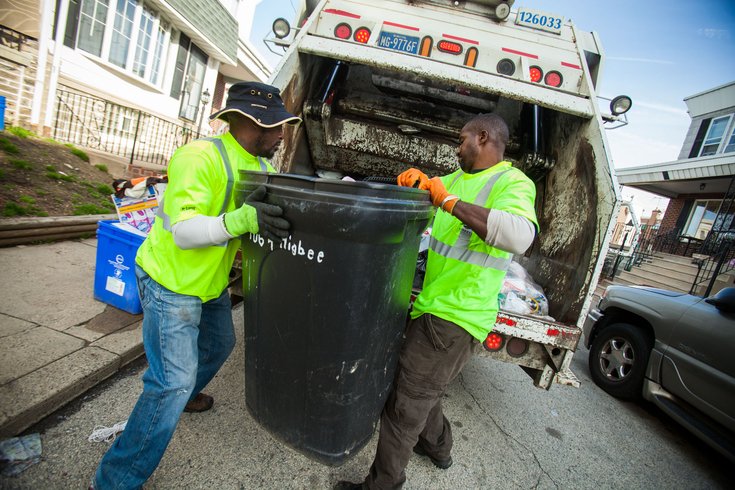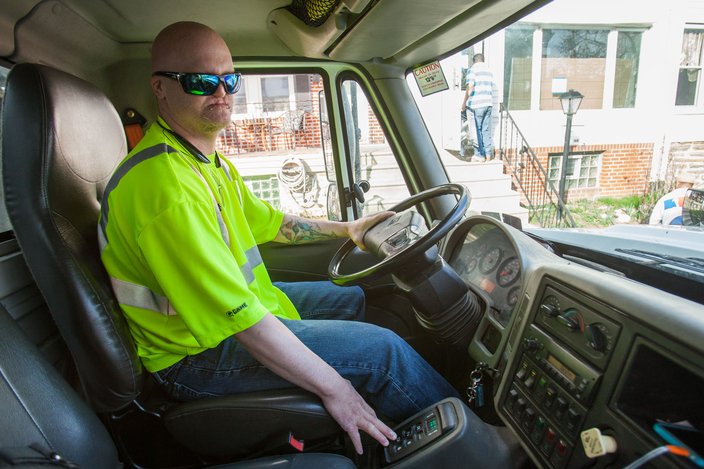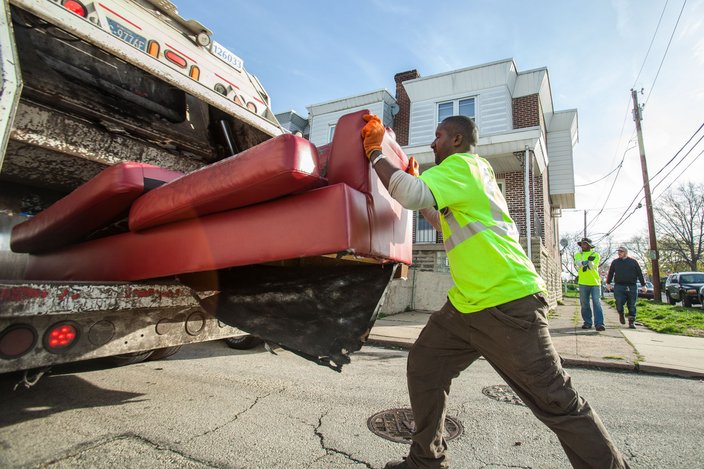Lawrence Heim’s head is on a swivel, checking mirrors, tracking impatient cars that mount the curb to get past the truck he pilots and making sure kids playing nearby stay at a safe distance.
When a vehicle or skateboarder zooms by, he honks to let his two co-workers know that they needed to be especially cautious.
“I have to pay attention to everything,” Heim said.
Heim's job: He drives a Philadelphia garbage truck. His main mission: keep his crew safe.
Vigilance is necessary, because while the job of keeping the city clean is not exactly heralded, it is among the most deadly. According to the Bureau of Labor Statistics, refuse collector was the most dangerous municipal job in America in 2013 when measured by fatality rate, and the fifth most dangerous type of employment overall behind roofers, aircraft pilots, fishermen and lumberjacks. The fatality rate for sanitation workers is 10 times higher than all workers, BLS reports.
Riding on the back of a trash truck leads to injuries, too. In 2004, the National Institute for Occupational Safety and Health reported that solid waste collection workers were
two times more likely to suffer lost workday injuries than the average service sector worker.
LARRY, BARRY AND SACKO
Last week, PhillyVoice accompanied a city garbage collection crew to better understand this physically demanding line of work and the dangers on the job.
“These guys who are out here generally don’t get a lot of credit,” said Joe Donatelli, a crew chief with the
Department of Streets. They work hard, however, and are in constant motion. The job is extremely physical, with workers heaving 50-pounds-or-more sacks of trash into the back of a truck – again and again and again. In the rain. Snow. Or
100-degree-plus heat.
Heim, 44, who sports a shaved head, reflective sunglasses and a horizontal piercing through his chin, has been with the department for 15 years.
Lawrence Heim, 44, of Mayfair has been with the department for 15 years. Thom Carroll/Philly Voice
He is paired with two other workers, Mamadou Sacko, 43, and Barry Williams, 46, who ride on the back of his truck, leaping off to clear sidewalks and streets of bags and other unwanted items left by residents. The trio – they call each other Larry, Barry and Sacko – have been a crew for about the past year, Heim said.
Overall, “it ain’t rocket science,” Heim said. But while the general tasks may be straightforward, the details are what matter, which can make the difference between injury and safety.
The hazards of the job are many.
Impatient drivers rush around the truck, putting workers at risk. Residents become resentful and combative over the truck’s pace. Trash bags that conceal harmful chemicals and sharp objects.
Heim learned that last one the hard way.
“I grabbed the bag, the glass went through the bag, and I [needed] five stitches,” he said of a past injury.
And then there is the compactor.
On the back of the truck is a hopper that uses a large metal blade to compact the trash with a downward motion and then pull it into the body of the truck. This allows the trucks to carry a full load of between 10 to 12 tons of refuse, according to Heim. A normal shift involves filling the truck twice.
The force of the hopper, however, can crush furniture and send parts flying. Heim remembered that back before he was a driver, he was hit squarely in the head by a broom handle that was sent flying by the hopper. The hydraulic pressure of the system is over 2,000 pounds per square inch, and employees quickly learn not to stand directly behind it.
On wet days, when water soaks through the garbage creating a kind of liquid ooze, the hopper can spray it back at workers. They say the accompanying smell is impossible to ignore. While the crew said it largely couldn’t sense the pungent odor anymore, the smell seeps into the cabin of the truck and is an unavoidable aspect of the job. Heim, joked that there were days when his wife wasn’t keen on hugging him when he got home.
BEHIND THE TRUCK, PERPETUAL MOTION
Philadelphia has not had a recorded death of a sanitation worker on the job over the past 20 years, according to June Cantor, a Streets Department spokeswoman. Still, the Streets Department averages about 800 injuries every year. Around 80 to 90 percent of those injuries are to sanitation workers, which make up about two-thirds of the department's staff.
Sprains and muscle strains of the back and shoulders are the most common, Cantor said, as sanitation workers collect a half million tons of Philadelphia household garbage a year.
On a small, lightly-trafficked residential street in Wissinoming, the crew works both sides of the street in one pass. Sacko and Williams pluck trash bags out of the garbage cans situated near the curb and throw them into an opening a few feet high in the back of the truck. It fills quickly, and then they have to “run the hopper.” This is done with two levers on the right side of the truck that prompts the blade to smash the garbage. Then they move to the next house. Both do a good job of not getting in the other's way.
“It is just communication,” Sacko said.
The compactor runs almost constantly. And the crew members do as well. They are in perpetual motion, with almost no time to pause. At one point, in about two minutes' time, crew members deposited most of a couch and several barrels of trash into the truck. When they get done with a pair of houses, the truck moves forward and they do the next ones.
“It is just like going to the gym,” Sacko said.
Mamadou Sacko lifts and loads a couch into the garbage truck by himself. Thom Carroll/Philly Voice
Drivers get paid in the high $30,000 range while laborers - the people who throw the trash in the back of the truck - are compensated commonly in the low $30,000s, according to the city’s website.
“You take care of yourself, you take care of your family,” said Sacko, adding that he was happy to have the job. “Money never comes easy.”
But you can't pay these guys enough to pick up what some folks leave at the curb. Like a dead dog, and a live turtle still in its tank, both of which they declined to pick up.
The weirdest thing seen by Heim? A headboard complete with two pairs of attached handcuffs.
Once, Heim said, he found a newspaper from the day Elvis died.
That souvenir he kept.

 Thom Carroll/Philly Voice
Thom Carroll/Philly Voice

